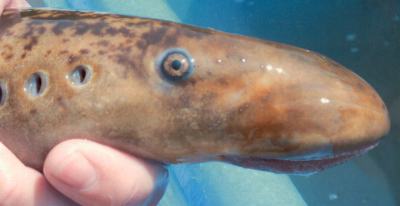One of Britain’s rarest and most bizarre looking fish is returning to the River Tamar in record numbers.
Environment Agency scientists have witnessed a resurgence in the sea lamprey population while monitoring salmon and sea trout on the River Tamar.
The Agency’s fish counter at Gunnislake records migrating salmon as they swim upstream to spawn. Video footage from the site in 2007 has revealed that sea lampreys have been migrating up the Tamar in much higher numbers than normal.
Like the salmon, the sea lamprey is a marine species that comes into rivers to spawn. It stops feeding when in fresh water and heads upstream in search of gravel beds to lay its eggs.
Measuring around a metre in length, the eel-like lamprey is a primitive species with a jawless sucker-like mouth. Unlike most fish, it is boneless and has a skeleton made of flexible cartilage. Also, it doesn’t have scales or paired fins. Young lamprey can live in riverbed silt for up to six years before finally turning into adults and migrating to sea.
The resurgence in lamprey numbers has been welcomed by the Agency as it indicates a healthy river environment. The Sea Lamprey is very sensitive to pollution and will only spawn in clean rivers.
‘The sea lamprey is something of an evolutionary throwback, but it is an important indicator species. This year more than 500 have passed through our fish counter at Gunnislake which is excellent news as it shows water quality in the Tamar is high,’ said Paul Elsmere for the Environment Agency.
‘Every so often there is a huge surge in lamprey numbers on the Tamar. The last bumper year was in 2000. We don’t fully understand why these fluctuations occur, but it could be linked to the sea lamprey’s rather unusual life cycle,’ said Paul Elsmere.
Sea Lamprey are thought to be even more sensitive to pollution than salmon so their presence on any river system is to be encouraged, ’At the moment they don’t receive much protection and are vulnerable as they are not as good at finding their way home to our rivers as other species such as salmon. The Agency together with other conservation bodies is considering classifying the sea lamprey as a freshwater fish to afford it greater protection and help ensure its survival,’ said Paul Elsmere.
For centuries sea lamprey were considered a delicacy in Europe. King Henry I, in a fit of royal gluttony, is said to have died from a ‘surfeit of lamprey.’ In Finland, hot-grilled lamprey it still a favourite dish.
The Environment Agency’s role is to ensure water quality is maintained and that activities affecting rivers and estuaries are sensitive to the requirements of sea lamprey. The Agency also works with partner organisations such as Natural England to raise awareness and help conserve these rare and mysterious animals.
There is no commercial fishery for sea lamprey in the UK and little is known of its behaviour at sea. However, once in freshwater they are eaten by predators including otters, heron and pike.
It feeds by attaching itself to other fish using its sucker mouth. Once attached it uses its sharp tongue to rasp a hole in the side of the fish before feeding on its host’s blood. The lamprey later detaches itself and swims off in search of its next meal. It rarely kills other fish.

Some Lamprey Facts:
- Lampreys are among the most primitive of all living vertebrate animals. They belong to a group known as Agnatha – literally ‘jawless fishes.’
- They only have one nostril – on the top of their head!
- The lamprey’s saliva contains an anti-coagulant that keeps a wound open so that it can continue to feast on the blood of its host.
- The male sea lamprey releases a powerful sex-hormone that females find irresistible. They can detect it up to 65 metres away. While insects are known to emit pheromones to attract mates, the lamprey is the first vertebrate creature to use a similar chemical ‘come-on.’









